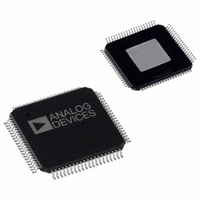AD9775BSVRL Analog Devices Inc, AD9775BSVRL Datasheet - Page 28

AD9775BSVRL
Manufacturer Part Number
AD9775BSVRL
Description
IC DAC 14BIT DUAL 160MSPS 80TQFP
Manufacturer
Analog Devices Inc
Series
TxDAC+®r
Datasheet
1.AD9775BSVZRL.pdf
(56 pages)
Specifications of AD9775BSVRL
Rohs Status
RoHS non-compliant
Settling Time
11ns
Number Of Bits
14
Data Interface
Parallel
Number Of Converters
2
Voltage Supply Source
Analog and Digital
Power Dissipation (max)
410mW
Operating Temperature
-40°C ~ 85°C
Mounting Type
Surface Mount
Package / Case
80-TQFP Exposed Pad, 80-eTQFP, 80-HTQFP, 80-VQFP
For Use With
AD9775-EBZ - BOARD EVALUATION FOR AD9775
AD9775
SLEEP/POWER-DOWN MODES
(Control Register 0x00, Bit 3 and Bit 4)
The AD9775 provides two methods for programmable
reduction in power savings. The sleep mode, when activated,
turns off the DAC output currents but the rest of the chip
remains functioning. When coming out of sleep mode, the
AD9775 immediately returns to full operation. Power-down
mode, on the other hand, turns off all analog and digital
circuitry in the AD9775 except for the SPI port. When
returning from power-down mode, enough clock cycles must
be allowed to flush the digital filters of random data acquired
during the power-down cycle.
TWO-PORT DATA INPUT MODE
The digital data input ports can be configured as two independ-
ent ports or as a single (one-port mode) port. In two-port mode,
data at the two input ports is latched into the AD9775 on every
rising edge of the data rate clock (DATACLK). Also, in two-port
mode, the AD9775 can be programmed to generate an externally
available DATACLK for the purpose of data synchronization.
This data rate clock can be programmed to be available at either
Pin 8 (DATACLK/PLL_LOCK) or Pin 53 (SPI_SDO). Because
Pin 8 can also function as a PLL lock indicator when the PLL is
enabled, there are several options for configuring Pin 8 and
Pin 53. The following sections describe the options.
PLL Off (Register 4, Bit 7 = 0)
Register 3, Bit 7 = 0; DATACLK out of Pin 8.
Register 3, Bit 7 = 1; DATACLK out of Pin 53.
35
30
25
20
15
10
5
0
Figure 51 I
0
CLKVDD
50
8 ×
vs. f
DATA
4 ×
vs. Interpolation Rate, PLL Disabled
f
DATA
100
(MHz)
150
2 ×
1 ×
200
Rev. E | Page 28 of 56
PLL On (Register 4, Bit 7 = 1)
Register 3, Bit 7 = 0, Register 1, Bit 0 = 0; PLL lock indicator out
of Pin 8.
Register 3, Bit 7 = 1, Register 1, Bit 0 = 0; PLL lock indicator out
of Pin 53.
Register 3, Bit 7 = 0, Register 1, Bit 0 = 1; DATACLK out of Pin 8.
Register 3, Bit 7 = 1, Register 1, Bit 0 = 1; DATACLK out of Pin 53.
In one-port mode, P2B14 and P2B15 from Input Data Port 2
are redefined as IQSEL and ONEPORTCLK, respectively. The
input data in one-port mode is steered to one of the two inter-
nal data channels based on the logic level of IQSEL. A clock
signal, ONEPORTCLK, is generated by the AD9775 in this
mode for the purpose of data synchronization. ONEPORTCLK
runs at the input interleaved data rate, which is 2× the data rate
at the internal input to either channel.
Figure 101 through Figure 104 illustrate the test configurations
showing the various clocks that are required and generated by
the AD9775 with the PLL enabled/disabled and in the one-
port/two-port modes. Jumper positions needed to operate the
AD9775 evaluation board in these modes are given as well.
PLL ENABLED, TWO-PORT MODE
(Control Register 0x02, Bit 6 to Bit 0 and
Control Register 0x04, Bit 7 to Bit 1)
With the phase-locked loop (PLL) enabled and the AD9775 in
two-port mode, the speed of CLKIN is inherently that of the
input data rate. In two-port mode, Pin 8 (DATACLK/PLL_
LOCK) can be programmed (Control Register 0x01, Bit 0) to
function as either a lock indicator for the internal PLL or as a
clock running at the input data rate. When Pin 8 is used as a
clock output (DATACLK), its frequency is equal to that of
CLKIN. Data at the input ports is latched into the AD9775 on
the rising edge of the CLKIN. Figure 52 shows the delay, t
inherent between the rising edge of CLKIN and the rising edge
of DATACLK, as well as the setup and hold requirements for
the data at Ports 1 and 2. The setup and hold times given in
Figure 52 are the input data transitions with respect to CLKIN.
Note that in two-port mode (PLL enabled or disabled), the data
rate at the interpolation filter inputs is the same as the input
data rate at Port 1 and Port 2.
The DAC output sample rate in two-port mode is equal to the
clock input rate multiplied by the interpolation rate. If zero
stuffing is used, another factor of 2 must be included to
calculate the DAC sample rate.
OD
,












